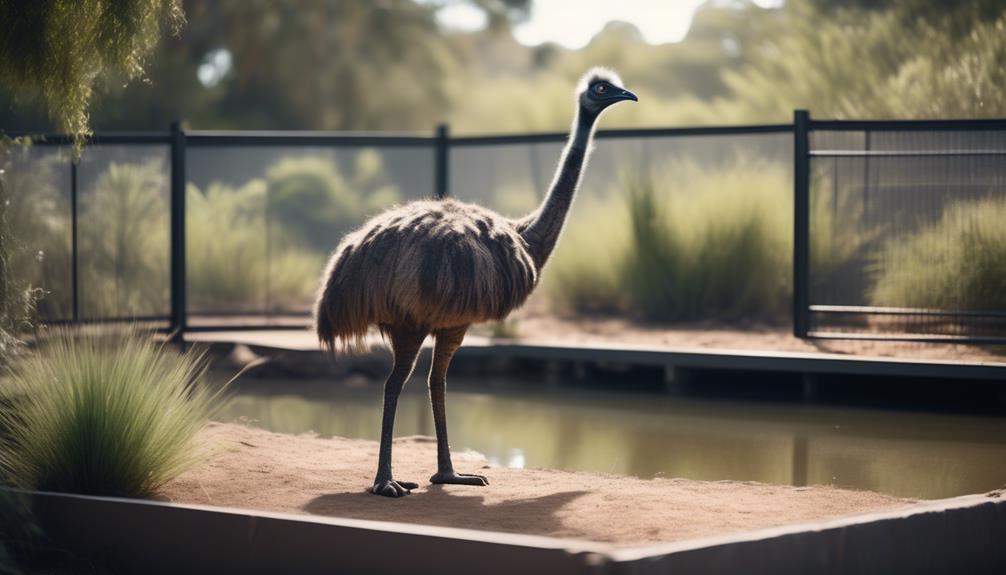
Are you ready to create the perfect enclosure for your emus? Look no further, as we dive into the world of design and construction tips that will ensure the utmost comfort and safety for these fascinating creatures.
From understanding their behavior to selecting the ideal location, we will explore everything you need to know to create a secure and enriching environment.
So, let's get started on this exciting journey towards building the best emu enclosure possible.
Understanding Emu Behavior
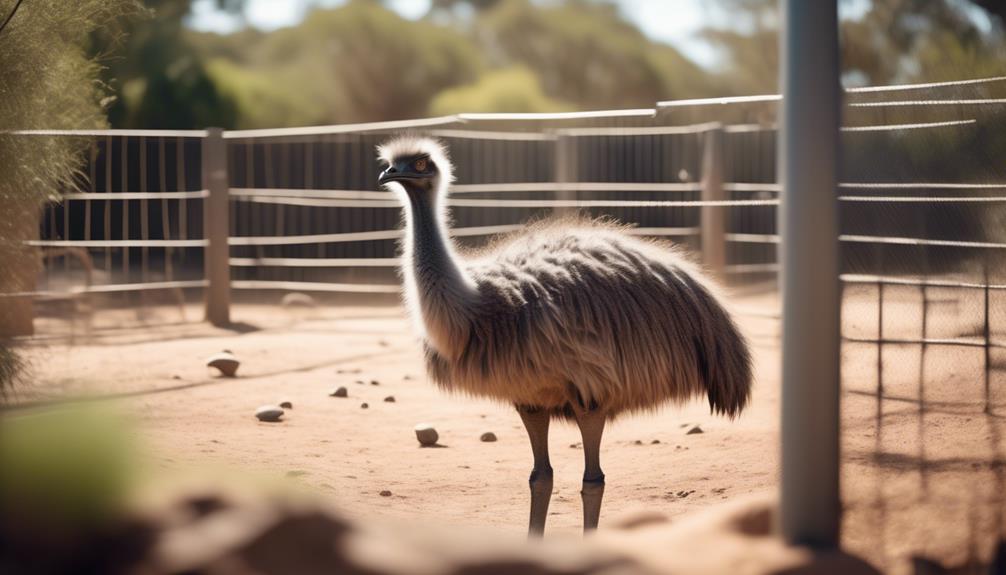
To effectively design and construct emu enclosures, it's crucial to have a comprehensive understanding of emu behavior. Emus have unique feeding habits that should be taken into consideration when planning their enclosures. These flightless birds are herbivores and primarily consume a diet of grass, flowers, fruits, and seeds. It's important to provide them with ample grazing space and vegetation that mimics their natural food sources.
Emu social interactions also play a significant role in enclosure design. Emus are known to be social animals that live in groups called mobs. Within these mobs, there's a hierarchical structure with dominant and submissive individuals. When designing emu enclosures, it's important to consider the space needed to accommodate these social dynamics. Providing separate areas where emus can establish their territories and retreat from dominant birds can help reduce aggression and stress.
Additionally, emus are known to exhibit mating behaviors during certain times of the year. It's important to provide suitable areas within the enclosure for mating rituals and nesting. This can include providing sheltered areas with soft bedding material for the females to lay their eggs.
Understanding emu feeding habits and social interactions is essential for designing emu enclosures that promote their well-being and natural behaviors. By considering these factors, you can create an environment that allows emus to thrive and live harmoniously within their captive settings.
Selecting the Right Location
Understanding the behavioral needs of emus is essential for selecting the right location to construct their enclosures. These fascinating creatures thrive in specific environmental conditions, and providing them with the ideal habitat is crucial for their well-being.
When choosing a location for emu enclosures, consider the following:
- Ideal Temperature: Emus are native to Australia, where they're adapted to hot and arid climates. It's important to select a location that offers a temperature range suitable for emus, typically between 60°F and 90°F (15°C to 32°C). This ensures that they're comfortable and can regulate their body temperature effectively.
- Predator Prevention: Emus are prey animals, and their enclosures should be designed to protect them from potential predators. Choose a location that's away from areas frequented by predators such as coyotes or foxes. Installing secure fencing and implementing additional measures like predator deterrents will help ensure the safety of the emus.
- Adequate Space: Emus are large birds that require ample space to roam and exercise. Select a location that provides enough room for them to move around freely. As a general guideline, allow at least 250 square feet (23 square meters) per emu.
- Environmental Considerations: Take into account the local climate and environmental factors. Avoid areas prone to flooding or extreme weather conditions that could potentially harm the emus. Additionally, ensure the location has access to fresh water and suitable vegetation for the emus to graze on.
Choosing the Ideal Size and Shape
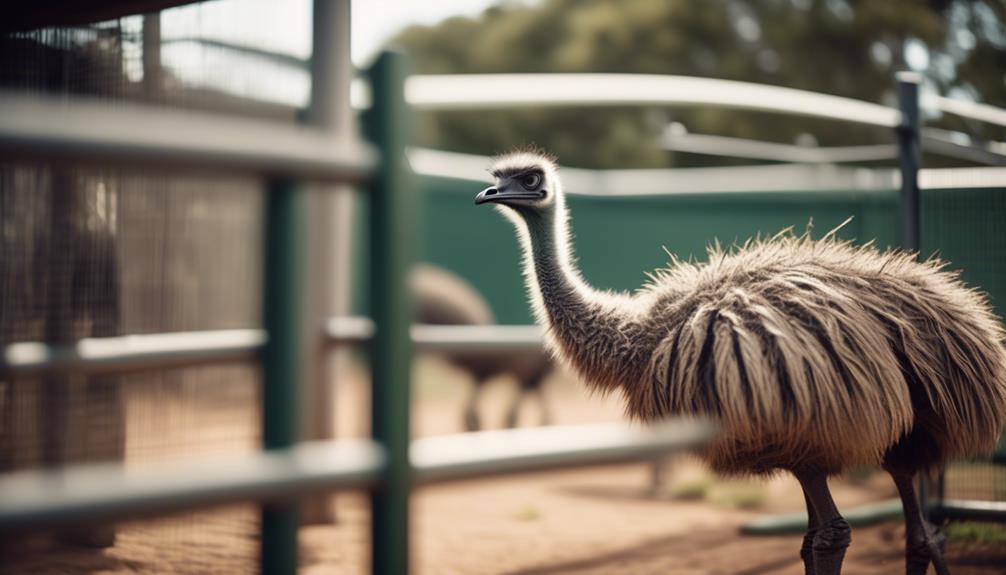
When choosing the ideal size and shape for emu enclosures, it's important to consider the specific needs and behaviors of these large birds. Emus are known for their impressive height, reaching up to 6 feet, and their remarkable speed, capable of running up to 30 miles per hour. These factors should be taken into account when designing their enclosures.
Emu enclosure design trends have shown that a circular or oval shape is preferable. This allows the emus to move freely and reduces the risk of them getting trapped in corners. The enclosure should be spacious enough to accommodate their large size and provide ample room for exercise and activities. A minimum of 350 square feet per emu is recommended to ensure their well-being.
Factors to consider when designing an emu enclosure include the height of the fence, which should be at least 6 feet high to prevent them from jumping over. The fence should also be secure and sturdy to withstand their powerful kicks. Additionally, the enclosure should have a solid roof to protect the emus from harsh weather conditions and potential predators.
Fencing Materials and Height Requirements
Considering the specific needs and behaviors of emus, the choice of fencing materials and height requirements for their enclosures is crucial for ensuring their safety and containment. To meet these requirements, here are four important factors to consider:
- Fence Durability: Emus are strong and curious birds, known for their ability to jump and push against fences. Therefore, it's essential to choose fencing materials that are durable and can withstand the emus' strength and inquisitive nature. Recommended options include chain-link fences or welded wire fences with a gauge of at least 12. These materials offer the necessary strength and resilience to keep emus securely contained.
- Height Requirements: Emus are tall birds that can reach up to 6 feet in height. To prevent them from jumping over the fence, it's recommended to construct the enclosure with a minimum height of 6 feet. However, it's advisable to add an additional foot for extra security, bringing the total fence height to 7 feet. This ensures that emus can't escape by jumping over the fence.
- Cost Analysis: When considering the cost of fencing materials, it's important to strike a balance between durability and affordability. While chain-link fences tend to be more cost-effective, they may require more maintenance compared to welded wire fences. Conducting a cost analysis will help you determine the best fencing option that meets your budget without compromising the safety and containment of your emus.
- Gate Security: The gate is a potential weak point in the enclosure that requires special attention. Ensure that the gate is constructed with the same durable materials as the rest of the fence and is securely locked. Emus are intelligent creatures and can figure out how to open gates if not properly secured. Regularly inspect the gate for any signs of wear or damage to maintain its integrity.
Providing Shelter and Shade
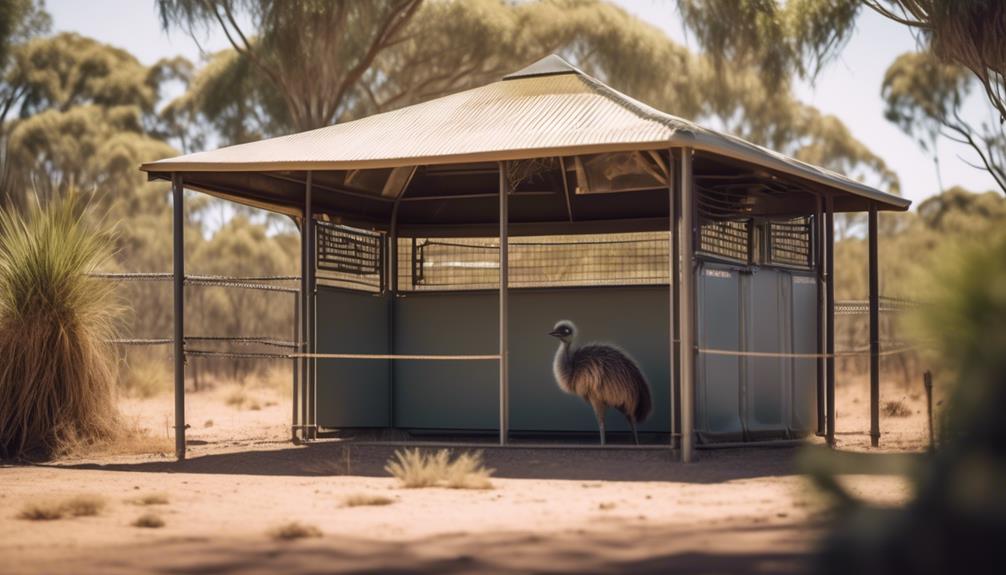
To ensure the comfort and well-being of your emus, it's essential to provide them with adequate shelter and shade within their enclosures. Emus are native to Australia and are well adapted to its harsh climate, so it's crucial to replicate their natural habitat as closely as possible. Emus are diurnal, which means they're active during the day and rest at night. Therefore, it's important to provide them with a shelter that offers protection from the elements, such as strong winds and heavy rain.
Additionally, emus are known to forage for food during the day, so their shelter should be strategically placed near their feeding areas.
When designing the shelter, consider the size and number of emus you intend to house. Emus are social animals, so it's recommended to provide a shelter that can accommodate multiple birds. The shelter should have a solid roof to shield the emus from rain and direct sunlight, while still allowing for adequate ventilation. Emus are also known to nest on the ground, so consider incorporating nesting boxes or suitable substrate materials within the shelter to meet their nesting habits.
In terms of shade, emus require a shaded area within their enclosure to protect them from the intense heat of the sun. This can be achieved by planting trees or erecting shade structures. Ensure that the shade area is large enough to accommodate all the emus and that it offers protection throughout the day as the sun moves across the sky.
Creating a Secure Entrance
If you want to ensure the safety and security of your emus, it's essential to carefully design and construct a secure entrance for their enclosure. A well-designed entrance not only prevents emus from escaping but also keeps potential intruders out.
Here are four key elements to consider when creating a secure entrance:
- Creating a double gate: A double gate system is highly effective in preventing emus from sneaking out when one gate is open. The two gates should be spaced a few feet apart, with a secure latch mechanism to ensure they remain closed at all times.
- Implementing motion sensors: Motion sensors are an excellent addition to the entrance, as they can detect any unauthorized movement nearby. When triggered, these sensors can activate an alarm or alert system, notifying you of potential threats in real-time.
- Sturdy fencing and locks: The entrance should be made of strong fencing material, such as chain-link or welded wire, to withstand the emus' size and strength. Additionally, using high-quality locks will further enhance security and prevent accidental openings.
- Proper lighting: Adequate lighting around the entrance is crucial for visibility during nighttime or low-light conditions. It not only helps you see potential hazards but also deters intruders who prefer darkness.
Flooring and Drainage Considerations
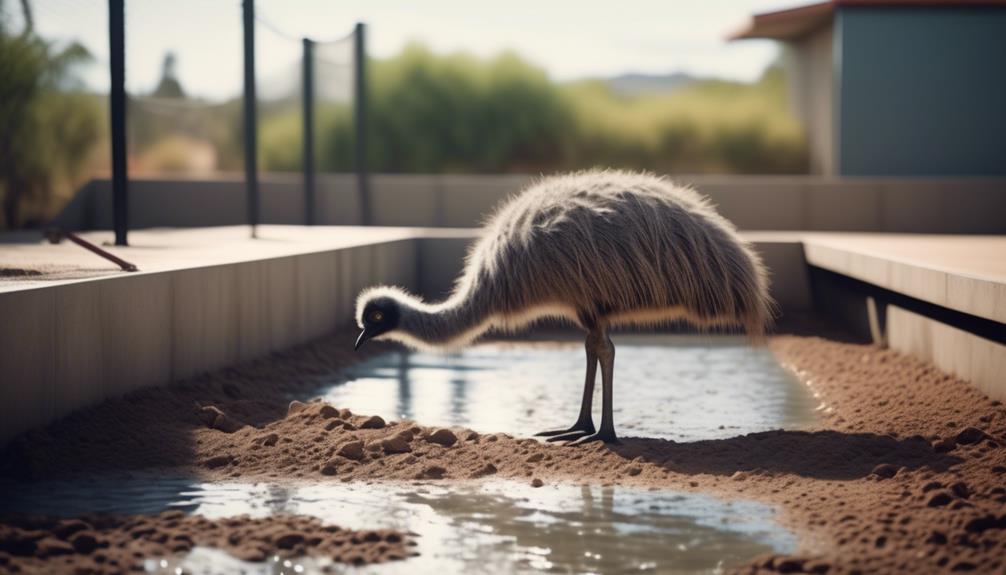
When designing the flooring for your emu enclosure, it is crucial to consider proper drainage to maintain a clean and hygienic environment. Emus produce a significant amount of waste, so it is essential to ensure that the flooring can effectively handle the water sources and waste that will accumulate in the enclosure. Additionally, proper drainage helps to prevent the growth of bacteria and the spread of diseases.
To achieve efficient drainage, you should consider using a combination of materials for the flooring. A popular option is to use a concrete base with a slight slope towards a central drain. This allows water and waste to flow away from the emus and towards the drainage system. Another option is to use a permeable flooring material such as gravel or crushed stone, which allows water to pass through and prevents puddles from forming.
In order to maintain temperature control within the enclosure, it is important to insulate the flooring. This can be achieved by adding a layer of insulation material such as foam or rubber beneath the concrete or gravel. Insulation helps to regulate the temperature and provides a comfortable surface for the emus to walk on.
Consider the following table for a better understanding of flooring and drainage considerations:
| Flooring Material | Drainage Efficiency |
|---|---|
| Concrete | High |
| Gravel | Medium |
| Crushed Stone | Medium |
Designing for Easy Cleaning and Maintenance
Designing for easy cleaning and maintenance in your emu enclosure requires careful consideration of various factors to ensure a smooth and efficient process. Here are four key aspects to keep in mind:
- Easy Access: When designing your emu enclosure, prioritize easy access points to all areas. This will allow you to clean and maintain the enclosure without any hassle. Consider installing large, durable doors that swing open wide for easy entry. Additionally, incorporate removable panels or gates to create smaller compartments within the enclosure, facilitating cleaning and preventing emus from interfering with the process.
- Proper Ventilation: Adequate ventilation is crucial for maintaining a healthy and odor-free emu enclosure. Ensure proper airflow by incorporating windows or vents that can be easily opened or closed as needed. This will help prevent the buildup of stale air and control humidity levels, reducing the risk of respiratory issues for your emus.
- Smooth Surfaces: Choose materials for the walls and flooring that are easy to clean and sanitize. Smooth surfaces, such as painted concrete or fiberglass, are ideal as they can be easily hosed down and disinfected. Avoid using materials with crevices or rough textures that can trap dirt, waste, or parasites.
- Drainage System: To facilitate efficient cleaning, design a proper drainage system in your emu enclosure. This should include sloped floors, strategically placed drains, and a well-connected plumbing system. By ensuring proper drainage, you can quickly and effectively remove excess water and waste, maintaining a clean and hygienic environment for your emus.
Adding Enrichment and Natural Elements
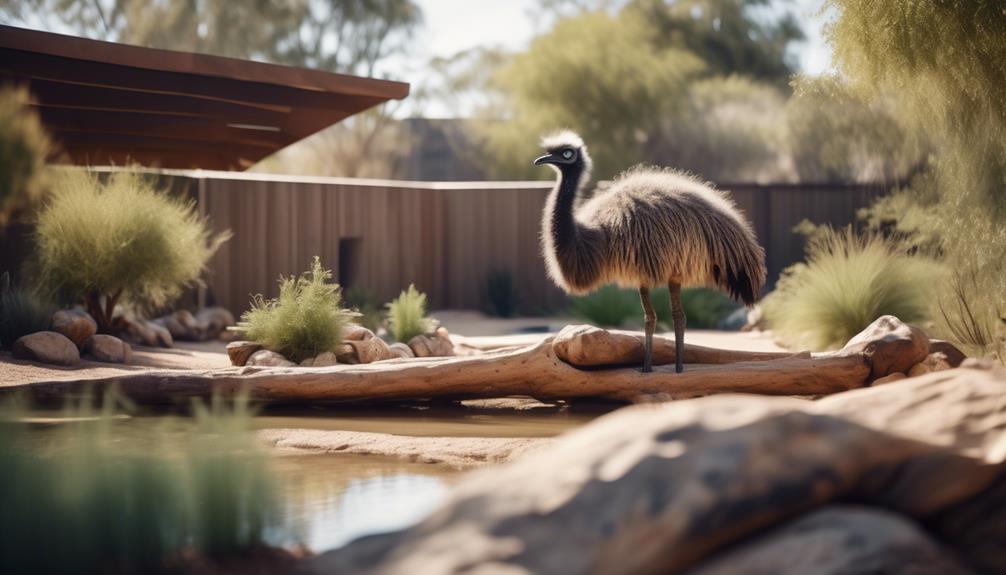
To enhance the well-being and mental stimulation of your emus, it's essential to incorporate enrichment activities and natural elements into their enclosure design. Emus are native to Australia and thrive in habitats that mimic their natural environment. Replicating the emu habitat in their enclosure can provide them with a sense of familiarity and security.
One key element to consider is the incorporation of water features. Emus are fascinated by water and enjoy wading in shallow pools. Adding a small pond or a shallow water basin to their enclosure can provide them with opportunities for bathing and cooling off. Ensure that the water is clean and regularly maintained to prevent the growth of bacteria or algae.
Another way to enhance the emus' enclosure is by including natural elements such as rocks, logs, and shrubs. These elements provide opportunities for the emus to explore, hide, and perch. Rocks can be arranged in different sizes and shapes to create a natural landscape, while logs can be used as perches for the emus to rest on. Shrubs and bushes can be strategically placed to provide shade and privacy.
Frequently Asked Questions
What Is the Average Lifespan of an Emu?
The average lifespan of an emu is around 10-20 years. Emus have unique breeding patterns, with males incubating the eggs and caring for the chicks. Proper enclosure design and construction is crucial for their well-being.
How Many Emus Should Be Kept Together in One Enclosure?
To ensure the well-being of your emus and prevent behavioral issues and potential breeding problems, it is recommended to keep a minimum of three emus together in one enclosure.
Can Emus Be Housed With Other Bird Species?
Emus should not be housed with other bird species due to their unique social behavior and hierarchical structure. Emus prefer to live in small groups, and introducing other species may disrupt their natural social dynamics.
What Is the Recommended Feeding Regimen for Emus?
To maintain optimal health and well-being for your emus, it is crucial to follow a recommended feeding regimen. Emus have specific nutritional requirements, and understanding their feeding habits is essential for their overall development and vitality.
Are There Any Specific Health Concerns or Diseases That Emus Are Prone To?
When it comes to emu health concerns, it's important to be aware of potential diseases they may be prone to. Taking preventive measures, such as regular check-ups and vaccinations, can help keep your emus in top condition.
Conclusion
Now that you have gained a deep understanding of emu behavior and the necessary considerations for designing and constructing their enclosures, you're well-equipped to create a safe and stimulating environment for these majestic birds.
By carefully selecting the right location, size, and shape, using appropriate fencing materials, providing shelter and shade, and incorporating enrichment and natural elements, you can ensure the well-being and happiness of your emus.
Get ready to witness these magnificent creatures thrive in their new home.




